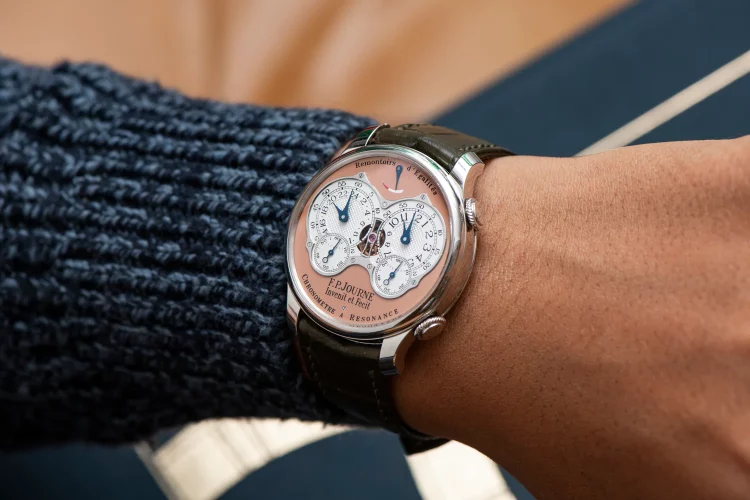Introduction
In the realm of luxury watchmaking, two names have recently emerged as prominent players with distinct approaches to both craftsmanship and technology: F.P. Journe and Hermès. While F.P. Journe is primarily associated with haute horlogerie, renowned for its mechanical complexity, innovative movements, and a clear focus on the art of timekeeping, Hermès, historically known for its expertise in fashion and leather goods, has successfully bridged the gap between traditional luxury and contemporary watchmaking with its refined, elegant designs and reliable Swiss movements.
Both brands cater to the world of high-end timepieces, but their methods of achieving excellence are vastly different, resulting in watches that not only reflect their unique heritage but also shape the direction of the watchmaking industry. How do F.P. Journe and Hermès balance craftsmanship and technological innovation in their watches? What sets each brand apart in terms of their engineering prowess and design philosophy?
This article will delve into the intricacies of craftsmanship, the technological advancements, and the philosophies behind the timepieces produced by F.P. Journe and Hermès, exploring how each brand has shaped its identity in the horological world.
1. F.P. Journe: Crafting Complicated Masterpieces
The Foundation of F.P. Journe’s Philosophy
Founded in 1999 by François-Paul Journe, F.P. Journe quickly earned a reputation as one of the most prestigious independent watchmakers in the world. Despite being a relatively new player compared to historic Swiss houses like Patek Philippe or Audemars Piguet, F.P. Journe’s innovative approach to mechanical movements, his emphasis on quality craftsmanship, and his personal philosophy of combining traditional watchmaking with modern technology, has earned the brand a devoted following among collectors and enthusiasts.
Journe’s approach to watchmaking is deeply rooted in engineering and functionality, which translates into highly complex movements. A hallmark of F.P. Journe’s craftsmanship is his commitment to in-house movements, where each timepiece is powered by mechanisms designed and built by the brand itself. In fact, the movement is often considered the soul of F.P. Journe watches, with a focus on precision, innovation, and uniqueness.
Technological Innovation: Mechanical Mastery
- The Resonance Principle One of the most notable examples of technological innovation in F.P. Journe’s collection is the Chronomètre à Résonance. This model, one of the brand’s flagship pieces, is based on the resonance principle, an unusual yet highly effective method of increasing the accuracy of a timepiece. The resonance mechanism allows two oscillators within the watch to influence each other, effectively improving the precision of the timekeeping. F.P. Journe’s approach to resonance in the Chronomètre à Résonance is based on natural resonance, in which two balances placed in close proximity to one another begin to synchronize their oscillations. This allows for a greater degree of accuracy than if the balances worked independently. This innovation is one of the reasons F.P. Journe’s watches are considered to be among the most precise in the world of horology.
- Tourbillons and Other Complications F.P. Journe has made significant strides in the creation of tourbillons, one of the most revered and complicated movements in the world of horology. His Tourbillon Souverain, for example, is a hand-wound masterpiece that highlights F.P. Journe’s technical genius. The tourbillon was invented to correct for the effects of gravity on a pocket watch’s accuracy, but F.P. Journe’s approach elevates the design to a whole new level of precision and mechanical artistry. Another notable complication in F.P. Journe’s lineup is the Octa Perpétuelle, which houses a perpetual calendar and a self-winding movement. The use of a rotor system that winds the watch and stores energy efficiently has been a standout innovation, earning the brand recognition for creating mechanical movements that are both sophisticated and highly functional.
- Materials and Finishing Another hallmark of F.P. Journe’s craftsmanship is the choice of materials used in both the movements and the cases of his timepieces. 18k rose gold is a signature material for F.P. Journe, and it is often used in the movement plates of the watches. This choice of material is not just about aesthetics—it contributes to the movement’s longevity and reliability, as well as ensuring an elegant look that stands the test of time. Movement finishing is another area where F.P. Journe excels. His watches are known for their fine detailing and hand-finishing. The circular graining, Côtes de Genève, and perlage found on the movement’s surfaces are all painstakingly done by hand, showcasing the dedication and passion that goes into every piece.
2. Hermès: Craftsmanship Meets Fashion Innovation
The Evolution of Hermès Watches
While Hermès is best known for its luxury goods—including leather handbags, scarves, and fashion—its watchmaking journey has proven to be one of careful evolution rather than revolution. The brand launched its first watches in 1928, initially focusing on crafting timepieces that could reflect the Hermès identity: elegance, understated luxury, and timeless beauty. Over time, the brand evolved to embrace Swiss-made mechanical movements and advanced watchmaking techniques while staying true to its fashion roots.
In contrast to F.P. Journe’s focus on technical complexity, Hermès watches often reflect a combination of sophistication and elegance rather than complicated mechanics. The brand’s collaborations with Swiss watchmakers such as Vaucher Manufacture and Jaeger-LeCoultre have allowed it to produce watches with reliable movements while incorporating design elements that make the watches unmistakably Hermès.
Technological Craftsmanship: Focus on Precision and Elegance
- The Slim d’Hermès: A Case Study in Simple Elegance The Slim d’Hermès collection represents the brand’s pursuit of precision and elegance. The case of the Slim d’Hermès is minimal and clean, featuring an ultra-thin profile and sleek lines. While the movement inside may not be as technically complicated as F.P. Journe’s, the watch is powered by a high-quality automatic movement manufactured in collaboration with Vaucher Manufacture. The Hermès Slim is a masterclass in elegance. The dial design is minimal but luxurious, featuring delicate Arabic numerals designed by Philippe Apeloig, a renowned graphic designer. The use of refined materials like platinum, rose gold, and alligator leather straps contributes to its sophisticated aesthetic, while the Swiss-made movements ensure that it keeps perfect time.
- The Arceau Collection: Design Meets Functionality Another iconic collection from Hermès is the Arceau, which embodies the brand’s emphasis on design and timelessness. The Arceau collection features an unmistakable circular case with horse-riding-inspired lugs, paying homage to the brand’s equestrian roots. The Arceau watches are powered by Swiss automatic movements, which Hermès sources from Jaeger-LeCoultre and other top-tier Swiss manufacturers. While the movements may not feature the complications found in more haute horlogerie brands, they are still known for reliability and precision.
- Crafting the Case: Leather, Ceramic, and More Hermès is known for its use of luxury materials. The company has leveraged its expertise in leather crafting to create alligator leather straps, which have become a signature of Hermès watches. Additionally, Hermès has expanded its use of materials like ceramic and rose gold to create timepieces that are both lightweight and visually striking. Another innovation from Hermès comes in the form of tactile and visual designs. The company places a strong emphasis on ergonomics, ensuring that its watches are comfortable to wear while maintaining the brand’s luxurious appeal. The case of a Hermès watch is often polished to perfection, and the combination of Swiss technology and Hermès design results in timepieces that are elegant and technologically reliable.

3. F.P. Journe vs. Hermès: A Comparison of Craftsmanship and Technology
Design Philosophy
- F.P. Journe is driven by the idea of mechanical excellence. The brand’s timepieces often feature avant-garde designs and complicated movements that highlight the brand’s focus on engineering and technological advancements. F.P. Journe’s watches are often intellectual and innovative, and they appeal to collectors who admire technical mastery.
- On the other hand, Hermès is primarily a fashion house, with its watchmaking focus on elegance and luxury. Hermès watches are designed with the goal of creating timepieces that reflect the brand’s aesthetic while delivering reliable and sophisticated timekeeping. Hermès places significant emphasis on materials and visual appeal, making its watches perfect for those who want a blend of style and functionality.
Craftsmanship and Technology in Movements
- F.P. Journe’s movements are masterpieces of mechanical engineering, with intricate complications that showcase the brand’s technical expertise. Models like the Chronomètre à Résonance and the Tourbillon Souverain are known for their cutting-edge movements that focus on precision, longevity, and innovation. The movements are created in-house, and the finishing is done to the highest standards, which appeals to horological purists.
- Hermès watches, while not as complicated as those by F.P. Journe, are known for their use of Swiss-made movements, which are reliable and precise. While Hermès watches may not boast grand complications like tourbillons or perpetual calendars, they still offer excellent functionality and reliability, with a focus on elegant design and fashion-forward aesthetics.
Conclusion: The Intersection of Craftsmanship and Technology
F.P. Journe and Hermès, despite their distinct approaches, both represent the pinnacle of luxury watchmaking. F.P. Journe’s emphasis on technical innovation, complicated movements, and masterful craftsmanship makes its watches a favorite among collectors who value mechanical brilliance. Hermès, meanwhile, showcases a different aspect of luxury—elegant, fashion-conscious designs powered by reliable Swiss movements, ensuring that its watches remain synonymous with sophistication and timeless style.
Whether you prefer the avant-garde technical innovations of F.P. Journe or the elegant design and functionality of Hermès, both brands demonstrate how craftsmanship and technology can coexist and evolve to create exceptional timepieces that stand the test of time.





































